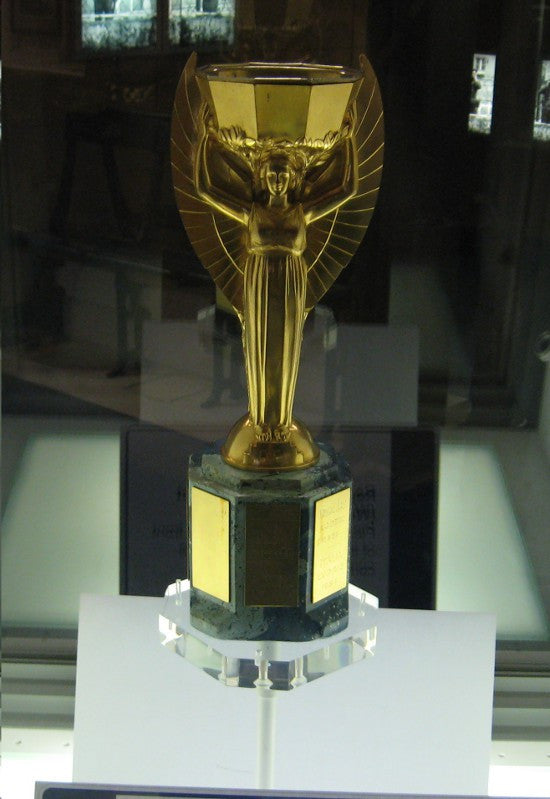84 years ago, in 1930, the inaugural World Cup tournament was held in Uruguay.
To match the bombast of the event, designer Abel Laflour was commissioned to design a trophy - which he based on the iconic Winged Victory of Samothrace that stands in the Louvre.
The silver and gold plate trophy has now been missing since 1983, its fate unknown. The story of how it came to be stolen and duplicated, on multiple occasions, is bafflingly complex.
 One of the many replicas of the Jules Rimet trophy |
The story begins with Uruguay's home victory in the first World Cup. The trophy was kept in the region for the requisite four years before it passed to Italy in 1934.
The side retained the trophy in 1938 and held it, away from the grasping hands of the Nazis (at one point it was hidden under the bed of FIFA vice-president Ottorino Barassi) until 1950 when the next event was held.
After West Germany achieved victory in 1954, the plot thickened. When the trophy reappeared in Sweden for the start of the 1958 tournament it was noticeably altered.
The base was thicker, the figure significantly taller.
 The Brazilian team holding the suspiciously altered trophy in 1958 |
It's widely believed that it was stolen and (sloppily) duplicated by person or persons unknown, although this has never been satisfactorily proven.
10 years later, in 1966, the trophy - whether the original or the duplicate - was definitely stolen - by petty thief Edward Bletchley who sent Scotland Yard a badly misspelled ransom note demanding £15,000 and later named a mysterious figure known as "The Pole" as the mastermind behind the theft.
It turned up a week later under a bush in south London after being discovered by a dog named Pickles - who predictably became a celebrity (a phenomenon clearly not confined to the internet era), received a lifetime supply of dog food and starred alongside Carry On star Eric Sykes in a spy spoof.
After the trophy was found, the FA secretly commissioned an exact bronze replica from jeweller George Bird. At this stage in the game, there are two - possibly three - Jules Rimets in circulation. Are you following?
To throw yet more smoke, the FA later bought the Bird replica at a 1995 auction for £254,500 - significantly higher than its £30,000 estimate.
They later confirmed that they believed it to be the original, although it turned out definitively not to be.
There's more.
In 1970 Brazil were given the trophy permanently under a rule that stated any country that won three times could keep it for good.
Until 1983, it remained safely under lock and key at the Brazilian Football Confederation HQ in Rio de Janeiro before it was stolen once more - this would be the last time, although one last replica was made in 1984.
The only suspect to the crime was found dead in 1989 - very dead in fact, he'd been shot seven times.
After Brazil's hat-trick of wins, FIFA replaced the Rimet with the World Cup Trophy - the unwieldy monster which remains in use to this day and was presumably designed to be as difficult as possible to walk out of a museum with.
Perhaps the original is still out there somewhere. But where? An Oligarchs vault? The back of a junk shop? On a car boot sale next to some aging Red Dwarf tapes?
Duplicity, corruption and outright deception.
There's surely no better symbol for the machinations of international football than the Jules Rimet trophy.






